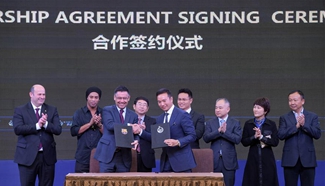SAN FRANCISCO, Feb. 24 (Xinhua) -- A researcher at the University of California, Berkeley, is working on a new type of lens that may do away with the classic convex piece of glass or plastic in cell phones with cameras.
Jie Yao, an assistant professor with UC Berkeley's Department of Materials Science and Engineering, is fabricating nano-thin sheets of phase change material that are glass-like at room temperature but becomes metallic when heated slightly.
The work is about "metamaterials," made of millions of nano-scale particles, each about the size of a virus, and made into arrays of nano-structures. They are so named because they perform unlike any other natural substances. Although the particles themselves are made of atoms, their novel effects on material's performance have earned them the name "artificial atoms."
With support from the Bakar Fellows Program, which fosters faculty entrepreneurship at UC Berkeley, Yao is trying to transform a natural phase change material in a way that seems like alchemy, turning some sections of the material into metal but leaving others unchanged.
The metallic portions can interact with light as if they were nanoscale antennas, and Yao has shown that in certain conformations, the combined effect of tens of thousands of these antennas can focus light like a lens.
"The metallic phase change material is the working part of the material, while the insulating part provides the matrix to hold the 'artificial atoms' in place," Yao was quoted as saying in a news release from UC Berkeley. With a local heat source, he is able to convert part of the thin sheets into the metal antennas while letting other parts remain transparent.
"Using a local heat source, we can 'write' new structures into the material. Then, by lowering the temperature, we can erase and re-write them. We can change the material's structure, and performance at will. No complicated nano-fabrication process is needed," he said.
By using this etch-a-sketch local heating strategy, his team can change the material's configuration in real time, potentially in less than a second. "In this we may be able to create a dynamic optical device, for example, a single lens whose focus can be changed whenever necessary."
The interactions of the nano-antennas with light are so effective that films hundreds of times thinner than a conventional lens could tightly control the path of light that passes through the film, Yao said.
"When a broad beam of light hits the array, it can be considered as composed of many finer beams. Each new beam passes by an antenna, which is able to change its unique path."
The array can be "written" in such a way that each antenna will guide light to the same focal point to form a lens. The next moment, the array can be erased and a new array may be written, and the focal point changed to another location, which could be used to improve the performance of photography and other imaging processes.
He intends to refine his technology's novel ability to tweak the metallic components' 3-D shape, and hopes to open up a range of applications to control visible light as well as infrared and microwave wavelengths.
"The material is a platform that allows us to draw any photonic structure, so we really can achieve a range of applications and transform them from static devices to dynamic ones," he said.












